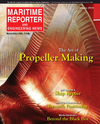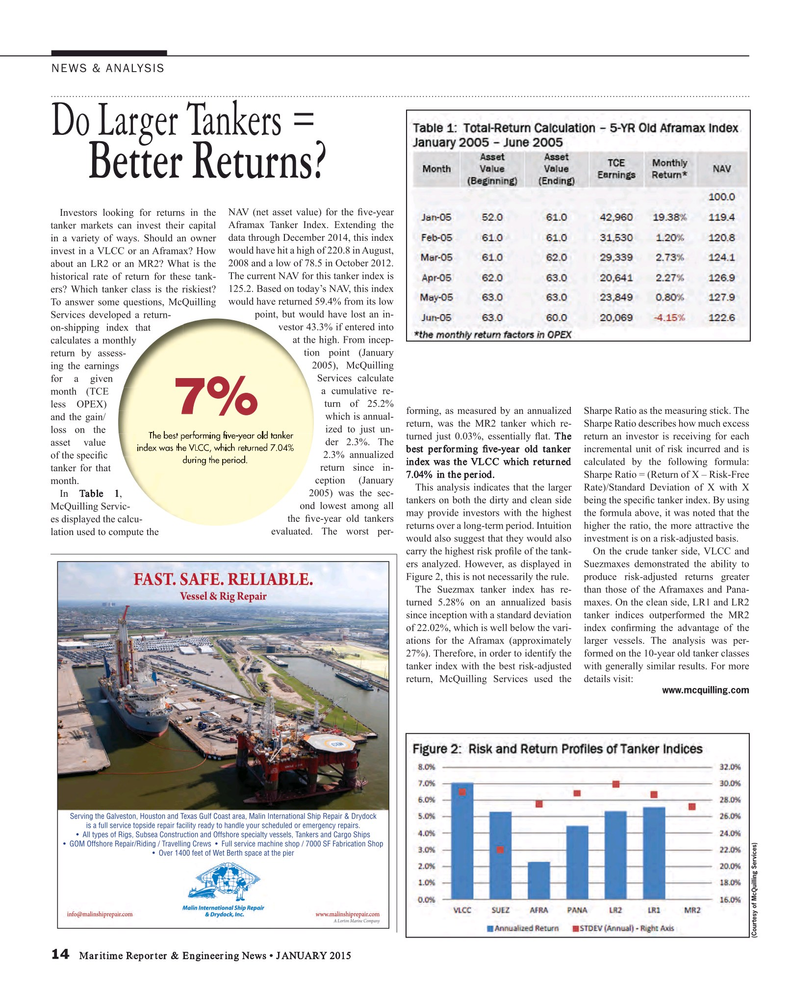
Page 14: of Maritime Reporter Magazine (January 2015)
Ship Repair & Conversion Edition
Read this page in Pdf, Flash or Html5 edition of January 2015 Maritime Reporter Magazine
NEWS & ANALYSIS
Do Larger Tankers = Better Returns?
Investors looking for returns in the NAV (net asset value) for the ? ve-year tanker markets can invest their capital Aframax Tanker Index. Extending the in a variety of ways. Should an owner data through December 2014, this index invest in a VLCC or an Aframax? How would have hit a high of 220.8 in August, about an LR2 or an MR2? What is the 2008 and a low of 78.5 in October 2012. historical rate of return for these tank- The current NAV for this tanker index is ers? Which tanker class is the riskiest? 125.2. Based on today’s NAV, this index
To answer some questions, McQuilling would have returned 59.4% from its low
Services developed a return- point, but would have lost an in- on-shipping index that vestor 43.3% if entered into calculates a monthly at the high. From incep- return by assess- tion point (January ing the earnings 2005), McQuilling for a given Services calculate month (TCE a cumulative re- turn of 25.2% forming, as measured by an annualized Sharpe Ratio as the measuring stick. The less OPEX) and the gain/ which is annual- return, was the MR2 tanker which re- Sharpe Ratio describes how much excess loss on the ized to just un- der 2.3%. The turned just 0.03%, essentially ? at. The return an investor is receiving for each asset value 2.3% annualized best performing ? ve-year old tanker incremental unit of risk incurred and is of the speci? c index was the VLCC which returned calculated by the following formula: tanker for that return since in- ception (January 7.04% in the period. Sharpe Ratio = (Return of X – Risk-Free month.
This analysis indicates that the larger Rate)/Standard Deviation of X with X
In Table 1, 2005) was the sec- ond lowest among all tankers on both the dirty and clean side being the speci? c tanker index. By using
McQuilling Servic- the ? ve-year old tankers may provide investors with the highest the formula above, it was noted that the es displayed the calcu- returns over a long-term period. Intuition higher the ratio, the more attractive the lation used to compute the evaluated. The worst per- would also suggest that they would also investment is on a risk-adjusted basis. carry the highest risk pro? le of the tank- On the crude tanker side, VLCC and ers analyzed. However, as displayed in Suezmaxes demonstrated the ability to
Figure 2, this is not necessarily the rule. produce risk-adjusted returns greater
The Suezmax tanker index has re- than those of the Aframaxes and Pana- turned 5.28% on an annualized basis maxes. On the clean side, LR1 and LR2 since inception with a standard deviation tanker indices outperformed the MR2 of 22.02%, which is well below the vari- index con? rming the advantage of the ations for the Aframax (approximately larger vessels. The analysis was per- 27%). Therefore, in order to identify the formed on the 10-year old tanker classes tanker index with the best risk-adjusted with generally similar results. For more return, McQuilling Services used the details visit: www.mcquilling.com
Serving the Galveston, Houston and Texas Gulf Coast area, Malin International Ship Repair & Drydock is a full service topside repair facility ready to handle your scheduled or emergency repairs. s

 13
13

 15
15
